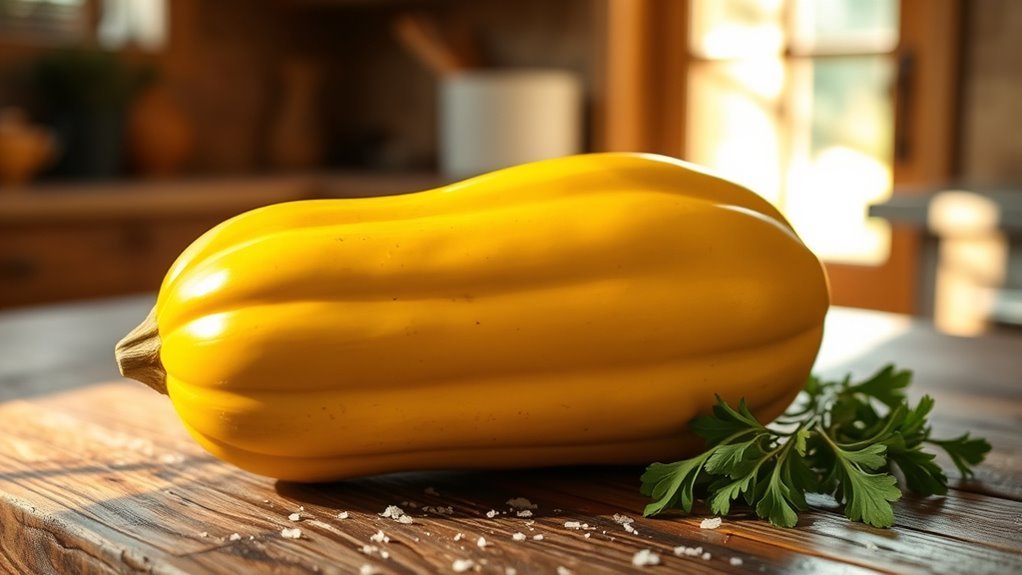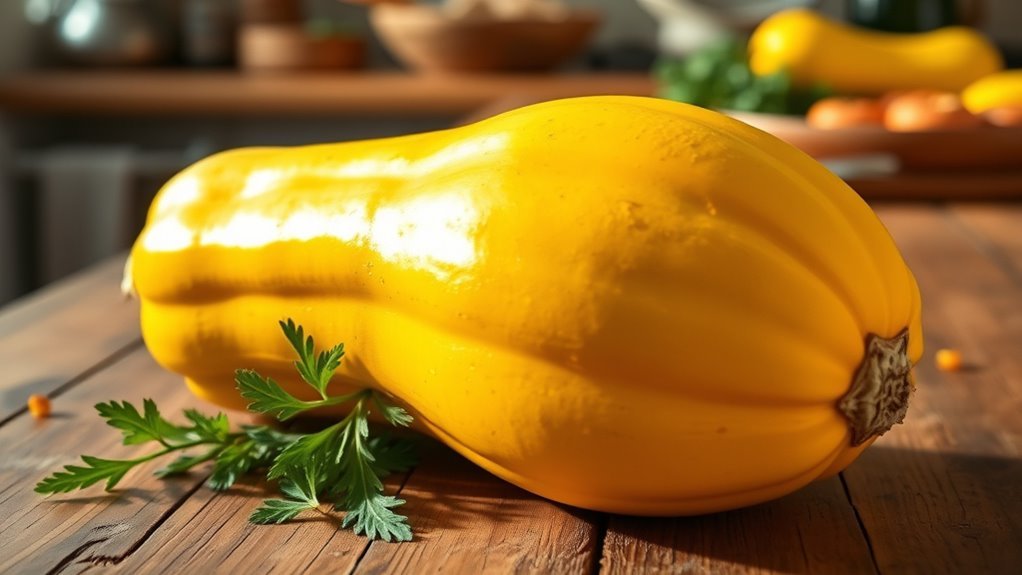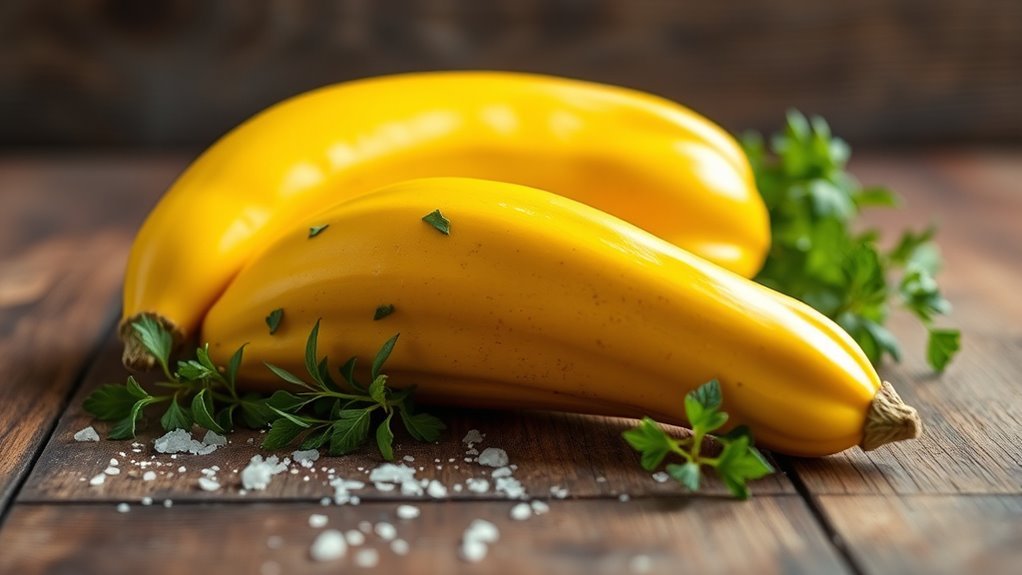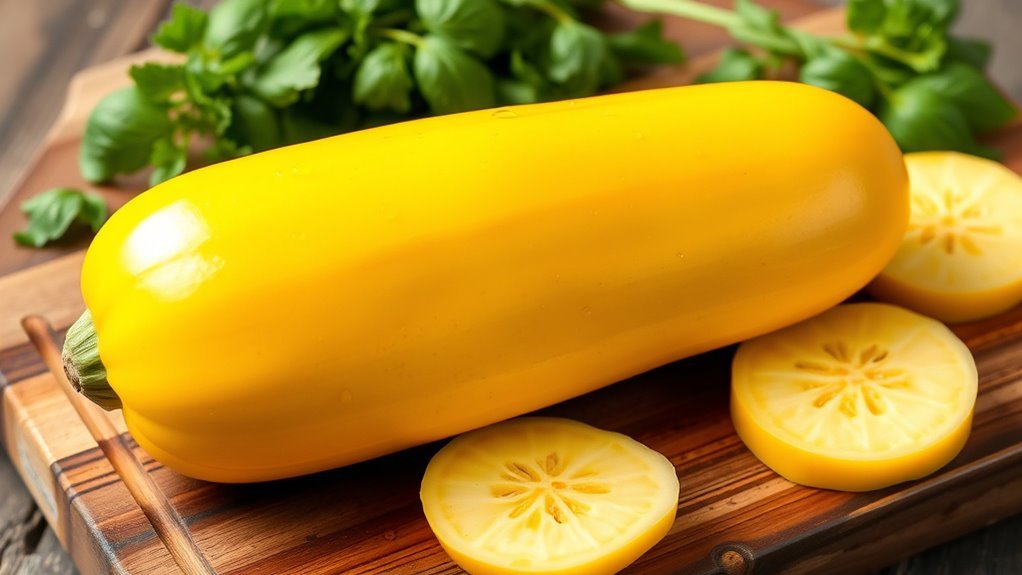Yes, yellow squash is keto-friendly! It has about 4 grams of net carbs per cup and is packed with essential nutrients like vitamins A, C, and potassium. This low-calorie vegetable offers fiber, which aids digestion and keeps you feeling full. You can easily incorporate it into your meals through various cooking methods like sautéing or grilling. If you want to discover more about its health benefits and meal prep ideas, you’ll find plenty of useful tips.
Nutritional Profile of Yellow Squash

When you slice into a fresh yellow squash, you’re not just enjoying its vibrant color; you’re also tapping into a nutrient-rich food. This versatile vegetable is low in calories and packed with vitamins A and C, which are essential for maintaining healthy skin and boosting your immune system. You’ll also find a good amount of potassium, crucial for heart health and muscle function. Yellow squash provides dietary fiber, aiding digestion and promoting a sense of fullness, making it a fantastic addition to your meals. Its antioxidants help combat oxidative stress, supporting overall wellness. Whether sautéed, grilled, or baked, the nutritional benefits of yellow squash make it a tasty and healthful choice for those seeking a balanced diet.
Carbohydrate Content and Keto Compatibility

When considering yellow squash in your keto diet, it’s vital to look at its carbohydrate content. A typical serving contains about 4 grams of carbs, which can fit into your daily limits, but portion control is key to staying within your goals. Understanding how this vegetable fits into your overall nutritional profile will help you make informed choices. Additionally, yellow squash offers nutritional benefits such as vitamins A and C, which can enhance your overall health.
Nutritional Profile Overview
Yellow squash, often celebrated for its versatility in the kitchen, offers a nutritional profile that can be intriguing for those following a ketogenic diet. With about 3-4 grams of carbohydrates per cup, depending on the yellow squash variety, it can fit into your daily carb limits. This makes it a suitable vegetable choice for keto enthusiasts. Additionally, the fiber content aids digestion, making your meals more satisfying. You can utilize various cooking techniques—like sautéing, roasting, or spiralizing—to enhance its flavor while keeping it keto-friendly. Incorporating yellow squash into your diet can provide essential vitamins and minerals without compromising your carb goals, granting you the freedom to enjoy flavorful dishes.
Portion Control Importance
To effectively manage your carbohydrate intake on a ketogenic diet, portion control becomes essential, especially with vegetables like yellow squash. While it’s low in carbs, eating large portion sizes can add up quickly. Practicing mindful eating helps you enjoy your meals while keeping your macros in check.
Here’s a quick reference for yellow squash:
| Portion Size | Carbohydrates (g) |
|---|---|
| 1 Cup (sliced) | 4.0 |
| 1 Medium Squash | 6.0 |
| 1/2 Cup (cooked) | 2.0 |
| 1 Cup (cooked) | 3.5 |
Health Benefits of Yellow Squash

When you consider adding yellow squash to your diet, you’ll find it’s packed with essential nutrients while remaining low in calories. This makes it a great choice for those looking to maintain a healthy weight without sacrificing vitamins and minerals. Additionally, yellow squash is rich in antioxidants, which can help combat oxidative stress in the body.
Nutrient-Rich Profile
While many vegetables boast impressive nutrient profiles, yellow squash stands out due to its rich content of vitamins, minerals, and antioxidants. This vibrant vegetable offers high nutrient density, packing essential nutrients into each low-calorie serving. It’s an excellent source of vitamin C, which supports immune health and skin liveliness, and vitamin A, essential for vision and cellular function. Additionally, yellow squash contains B vitamins like folate, important for energy metabolism. The mineral content, including magnesium and potassium, contributes to muscle function and heart health. Antioxidants such as lutein and zeaxanthin help protect your cells from damage. By incorporating yellow squash into your diet, you’ll enjoy a nutrient-rich option that supports overall well-being and freedom in your food choices.
Low-Calorie Option
Although many diets emphasize calorie control, yellow squash emerges as a satisfying and low-calorie option that can enhance your meals without compromising flavor. This versatile vegetable is perfect for those seeking low-calorie meals or squash alternatives.
Consider these benefits of incorporating yellow squash into your diet:
- Low in Calories: With just 18 calories per cup, it’s an excellent choice for weight management.
- High in Water Content: This helps you feel full without adding extra calories.
- Versatile Ingredient: Use it in salads, stir-fries, or as a pasta alternative for a nutritious twist. Additionally, yellow squash is low in carbohydrates, making it suitable for a keto diet.
Antioxidant Properties
In addition to being a low-calorie option, yellow squash boasts impressive antioxidant properties that can contribute to overall health. The antioxidants found in yellow squash, including vitamin C and beta-carotene, help combat oxidative stress in your body. This means they can protect your cells from damage caused by free radicals, which are linked to chronic diseases and aging. Incorporating yellow squash into your diet may enhance your immune function and promote skin health, thanks to its antioxidant benefits. Plus, these compounds can support eye health by reducing the risk of age-related macular degeneration. So, if you’re seeking a nutrient-dense vegetable that aligns with a keto-friendly lifestyle, yellow squash is a smart choice for both flavor and health.
Ways to Prepare Yellow Squash on a Keto Diet
Yellow squash is a versatile and nutritious option for those following a keto diet, offering a range of preparation methods that can enhance its flavor and fit seamlessly into your meal plan. Here are some keto-friendly recipes you can try:
Yellow squash is a nutritious, versatile ingredient perfect for keto diets, with various preparation methods to enhance its flavor.
- Sautéing: Lightly sauté yellow squash in olive oil with garlic and herbs for a quick, flavorful side dish.
- Grilling: Slice the squash, brush with olive oil, and grill for a smoky taste that complements any protein.
- Baking: Hollow out the squash and fill it with a mix of cheese and spices, then bake until tender for a delicious, low-carb treat.
These methods not only preserve the nutrients but also allow you to enjoy yellow squash as part of your keto lifestyle.
Recipes Featuring Yellow Squash for Keto Meals
When you’re looking to incorporate yellow squash into your keto meals, you’ll find that its mild flavor and low carbohydrate content make it an ideal ingredient. Try a yellow squash stir fry, combining it with bell peppers, broccoli, and garlic for a colorful, nutrient-dense dish. Alternatively, consider a yellow squash casserole, layering slices with cheese and spices for a comforting meal that satisfies your cravings while keeping carbs in check. Including low-carb vegetables like yellow squash helps you maintain your ketogenic goals while enjoying a variety of flavors.
Here’s a quick comparison of both dishes:
| Dish | Carbs per Serving | Preparation Time |
|---|---|---|
| Yellow Squash Stir Fry | 5g | 20 minutes |
| Yellow Squash Casserole | 7g | 40 minutes |
These dishes not only taste great but also align perfectly with your keto lifestyle!
Serving Sizes and Portion Control
Understanding serving sizes and portion control is essential for maintaining a ketogenic diet, especially when incorporating ingredients like yellow squash. While it’s low in carbs, you’ll want to be mindful of how much you’re eating to stay within your macronutrient goals.
Understanding portion control is key on a ketogenic diet, particularly with low-carb ingredients like yellow squash.
Consider these serving suggestions to optimize your intake:
- A half-cup of cooked yellow squash contains around 4 grams of net carbs.
- Aim for 1 to 2 cups per meal, depending on your overall carb allowance.
- Pair it with higher-fat foods to maintain a balanced keto plate.
Comparing Yellow Squash to Other Low-Carb Vegetables
While yellow squash is a popular choice among low-carb vegetables, it’s important to compare it with other options to determine the best fit for your ketogenic diet. In a nutritional comparison, yellow squash typically contains about 4 grams of net carbs per cup, making it a solid choice. However, when evaluating alternatives like zucchini or spinach, you might find similar or lower carb counts. Zucchini, for instance, has roughly 2 grams of net carbs per cup, while spinach offers only 1 gram. Each vegetable brings unique vitamins and minerals to the table. Ultimately, your selection should align with your personal taste and nutritional goals, ensuring you enjoy the freedom to customize your keto meals while staying within your carb limits. Notably, spaghetti squash’s low-carb content makes it another versatile option for those on a ketogenic diet.
Tips for Choosing and Storing Yellow Squash
Choosing the right yellow squash can enhance your keto meals, so it’s essential to know what to look for. Aim for a fresh selection by checking for firmness and vibrant color. Here are some tips to help you:
Selecting fresh yellow squash is key to elevating your keto dishes; focus on firmness and vibrant color for the best results.
- Look for smooth, unblemished skin; avoid any with soft spots or wrinkles.
- Choose smaller squash, as they tend to be sweeter and more tender.
- Sniff the stem end; a fresh squash should smell slightly sweet.
For proper storage, keep your yellow squash in the refrigerator’s crisper drawer in a breathable bag. This helps maintain freshness for up to a week. By selecting and storing your yellow squash correctly, you’ll guarantee it remains a delicious, keto-friendly staple in your meals.
Frequently Asked Questions
Can Yellow Squash Fit Into a Vegetarian Keto Diet?
Absolutely, yellow squash can fit into a vegetarian keto diet! It’s low in carbs and packed with nutrients, making it a great choice for your meals. You can create delicious squash recipes such as spiralized squash noodles or stuffed squash boats. Just be mindful of portion sizes to maintain your carb limits. So, embrace yellow squash in your vegetarian keto journey and enjoy its versatility and health benefits!
Is Yellow Squash Safe for Those With Nightshade Allergies?
Yellow squash is actually safe for those with nightshade allergies since it isn’t a nightshade vegetable. Nightshade alternatives like zucchini or bell peppers can also be considered if you’re looking for variety. While yellow squash allergies can occur, they’re relatively rare. If you experience any adverse reactions, it’s best to consult a healthcare professional. Enjoy experimenting with different veggies to maintain a vibrant, allergy-friendly diet that suits your needs!
How Does Yellow Squash Impact Blood Sugar Levels?
Yellow squash’s impact on blood sugar is primarily positive, providing plenty of nutrients without spiking levels. This delightful vegetable is low in carbohydrates, making it a fantastic choice for maintaining stable blood sugar. Its fiber content helps slow digestion, which can further promote balanced glucose levels. So, if you’re looking for a satisfying side that won’t send your blood sugar soaring, yellow squash could be your go-to green delight!
Can Yellow Squash Be Frozen for Later Use?
Yes, you can freeze yellow squash for later use. To do this effectively, blanch the squash in boiling water for a few minutes, then cool it quickly in ice water. This technique helps preserve its texture and nutrients. Once cooled, store it in airtight freezer bags. Properly frozen, yellow squash can last up to 12 months. Just remember to label your bags for easy identification when you’re ready to use it!
What Are the Best Spices to Complement Yellow Squash?
When you think of yellow squash, picture a blank canvas ready for vibrant colors. To enhance its natural sweetness, try spice combinations like garlic powder and paprika for a smoky finish, or fresh herbs like thyme and rosemary for earthy flavor profiles. If you’re feeling adventurous, a pinch of cumin can add warmth. These spices not only elevate the dish but also free your culinary creativity, making each bite a delightful experience.


